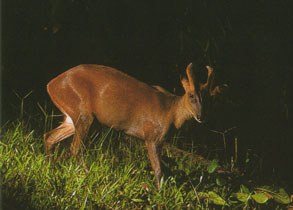
|
|
General Information
Considered as primitive members of the Cervidae family, the barking deer or the India Muntjac weighs between 20 to 30 kg with a shoulder height of under 120cm.The body colour varies from deep brown to yellow or grey brown. Antlers, while short ,are carried on long, bony hair-covered pedicles which originate from the brows and not the top of the head. The upper canine teeth of the males are elongated into tusks, which curve outward from the lips. Females have small bony knobs and tufts of hair where the antlers occur in the males.
Habitat
Solitary and shy, they live in the forests of India and Nepal to southern
China, Tibet, Sri Lanka, Mainland Malaysia and the Indonesian islands. They
may live up to 17 years if in captivity.
Feeding and Breeding
It survives on a diet of leaves, shoots, tender grasses and fallen fruit. Females may begin to breed within a year of age . Gestation is about 210 days and a single young is born in the dense jungle growth . it will hide till it can move about with its mother.
Conservation
Muntjacs are hunted for their meat and skins. They are considered a nuisance in some areas because they destroy trees by ripping off the bark. Although some species of muntjac are rare and endangered, the Indian muntjac is still holding its own.
Interesting Facts
The male's tusks are capable of inflicting serious injuries to other animals. Both males and females make a deep barking sound when they are alarmed.
The muntjac's status in Malaysia :
The Indian muntjac has long been a favourite animal of Malay sultans and was in the past featured on gold coins. In more modern times, it is featured in the state crest of Kelantan as well as the logo of Bank Negara.
Bibliography
1. Linden, Eugene. 1994. "Ancient Creatures", Time Magazine, 6/20/94, p. 52.
2. Nowak, Ronald. 1991. Walker's Mammals of the World, Vol. 2. Johns Hopkins University Press, Baltimore, MD, pp. 1366-8.
3. On line animal Catalogue
This website is best viewed using Internet Explorer at 800 X 600 resolution